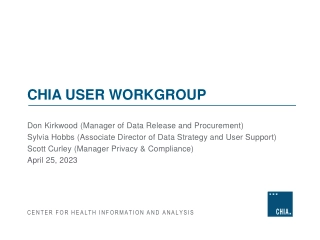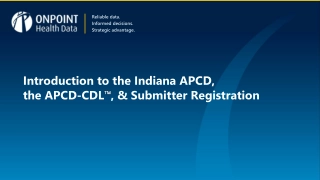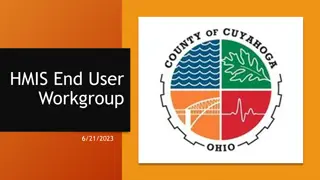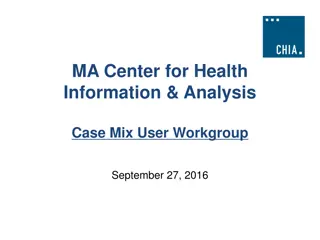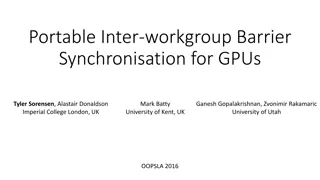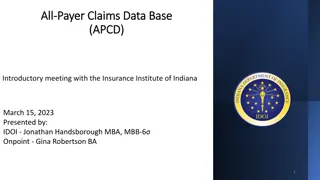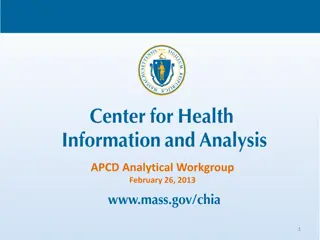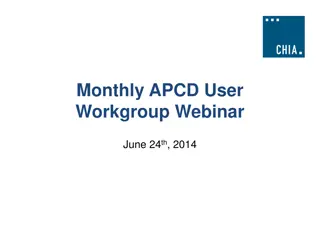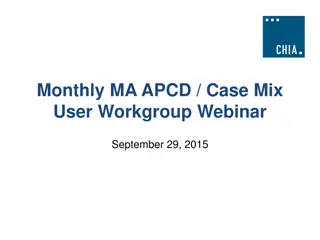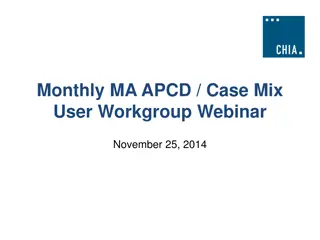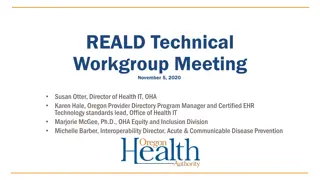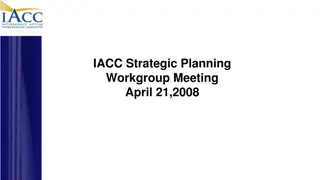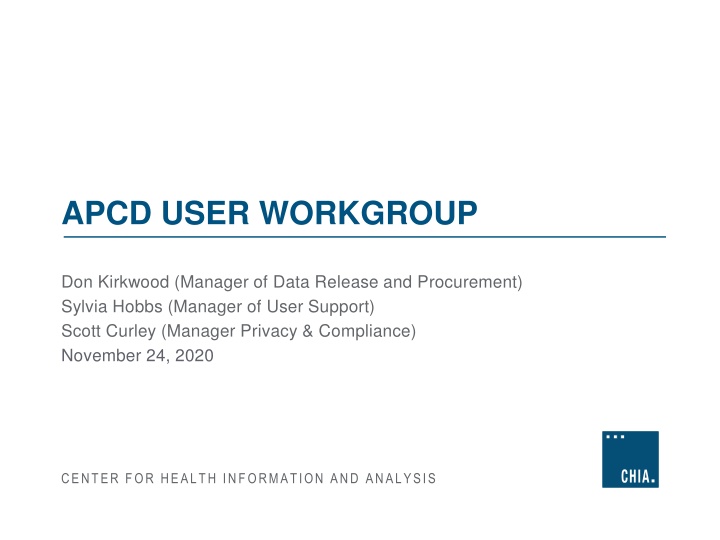
APCD User Workgroup Meeting Highlights and Updates November 2020
Stay updated on the latest information shared during the November 2020 APCD User Workgroup meeting, including APCD Release 8.0 updates, Case Mix FY19 release details, and important announcements regarding data release and application updates amidst COVID-19. Explore the key takeaways and important instructions provided by CHIA for data users and requestors.
Download Presentation

Please find below an Image/Link to download the presentation.
The content on the website is provided AS IS for your information and personal use only. It may not be sold, licensed, or shared on other websites without obtaining consent from the author. If you encounter any issues during the download, it is possible that the publisher has removed the file from their server.
You are allowed to download the files provided on this website for personal or commercial use, subject to the condition that they are used lawfully. All files are the property of their respective owners.
The content on the website is provided AS IS for your information and personal use only. It may not be sold, licensed, or shared on other websites without obtaining consent from the author.
E N D
Presentation Transcript
APCD USER WORKGROUP Don Kirkwood (Manager of Data Release and Procurement) Sylvia Hobbs (Manager of User Support) Scott Curley (Manager Privacy & Compliance) November 24, 2020 CENTER FOR HEALTH INFORMATION AND ANALYSIS
Agenda Announcements: APCD Release 8.0 Updates FY19 Case Mix Release Projections Data Release and Application Update Website Updates Application Reminders User Support Questions Insurance Type Code 'ZZ' Expected National Provider Identifier (NPI) Volume Difference between Carrier Specific Unique Member ID and MemberLink EID ICU length of Stay Codes for Mechanical Ventilation and Respiratory Volume Q&A 2 User Workgroup | CHIA User Support
MA APCD Release 8.0 Available NOW Applicants with approved projects that require updated APCD data (Release 8.0) should submit to CHIA a completed Exhibit B (Certificate of Continued Need and Compliance) of the Data Use Agreement. After submitting a completed Exhibit B you will receive an invoice (if applicable) for the requested data. Upon payment of the invoice the order for the data will be placed. Release 8.0 includes data on services from January 2014 December 2018 with six months of claim runout (includes paid claims through 6/30/19). Will be linkable to Release 7.0 via crosswalk Additional information on highlights and enhancements will be presented in future APCD User Workgroups. 3 User Workgroup | CHIA User Support
Case Mix FY19 Release *CURRENT* RELEASE TIMEFRAMES FOR EACH FILE: Inpatient (HIDD) Available for request and delivery Emergency Department (ED) Available for request and delivery Outpatient Observation (OOD) Applicants with approved projects that require newly available year(s) of Case Mix Data (e.g., FY 19) should submit to CHIA a completed Exhibit B (Certificate of Continued Need and Compliance) of the Data Use Agreement. After submitting a completed Exhibit B you will receive an invoice (if applicable) for the requested data. Upon payment of the invoice the order for the data will be placed. Available for request and delivery 4 User Workgroup| CHIA User Support
Data Release and Application Updates Due to Governor Baker s emergency actions to limit the spread of COVID-19 CHIA s workforce will be remote, for now. This arrangement will limit CHIA s ability to produce and deliver data extracts. At this time, CHIA is releasing data and providing extracts to requestors. During this time, CHIA will continue to accept and review data applications for both Case Mix and All-Payer Claims Database (MA APCD) datasets. Review committees, DRC and DPC, will continue their meetings remotely as necessary. Due to CHIA s physical office being closed, applications will be accepted without a fee. After receipt of the application, CHIA will issue an invoice which will allow applicants to remit payment online. If you are a Data User that has a CHIA hard drive in your possession, please keep the hard drive at this time while CHIA s physical office is closed. 5 User Workgroup| CHIA User Support
Website Release Updates Updates on the production of APCD and Case Mix databases and status of data requests are now posted to CHIA s website! Aim #1 is to provide weekly or bi-weekly status update on CHIA data products as they are in development. Aim #2 is to provide applicants with information about expected fulfillment status for individual data requests. Request IDs will be communicated to Data Requestors via email. Please visit http://www.chiamass.gov/status-of-data-requests/ to see the current status of releases. User Workgroup| CHIA User Support 6
Fee Waiver Request Reminders 1. If you re submitting a request for a fee waiver, remember to include the fee remittance form in your application package on IRBNet. Remember to submit supporting documentation (if required). If you re requesting a financial hardship waiver, remember to submit information detailing your project s financial situation (examples: project budget, grant funding, organizational / departmental funding). Also request to pay a specific price that you reasonably believe you re able to afford to contribute. CHIA generally does not offer full financial hardship fee waivers. We expect all applicants to have made an attempt to find funding to cover the full cost of the data fees. Fee waiver requests can take some time to process especially financial hardship requests. 2. 3. 4. 5. 8 User Workgroup | CHIA User Support
Question Question: The claims and member eligibility file have an insurance type code product : The claims and member eligibility file have an insurance type code product field coding option of ZZ field coding option of ZZ . The . The ANSI Accredited ANSI Accredited Standards Committee X12's claim claim filing indicator filing indicator code defines code ZZ as Mutually Defined/ Unknown and the code defines code ZZ as Mutually Defined/ Unknown and the CHIA filing specifications simply define ZZ as Other. Mutually Defined and Other CHIA filing specifications simply define ZZ as Other. Mutually Defined and Other are ambiguous. Can you clarify what this code refers to? are ambiguous. Can you clarify what this code refers to? Insurance Type Code Product ZZ Standards Committee X12's (ASC (ASC X12) X12) Answer: Insurance Type Code Product (MC003, PC003, DC003) and Product Line of Business Code (PR004) ZZ occurs most commonly on pharmacy claims. In MA APCD Release 7.0, code ZZ is used each year on average 5% of members filing pharmacy claims and 1% of members filing medical claims. See Figure 1 below. The number of members filing dental claims with code has increased each year from under 1% in 2013 to 4% in 2017. Figure 1. Calendar Years 2013 to 2017 Count of Distinct Member Link EIDs with Insurance Type Product Code ZZ (MC003, PC003, DC003) by Claims Type Pharmacy Claims Medical Claims Dental Claims 245,000 208,216 207,852 210,000 182,851 175,000 151,089 136,547 140,000 97,876 105,000 65,741 70,000 52,077 50,093 42,011 35,000 13,014 12,861 8,109 904 5,157 - 2013 2014 2015 2016 2017 Continued Continued
Answer (continued): When the total distinct Member Link EIDs with Insurance Type Code Product ZZ in the claims files are linked to the Product file for information on the associated Carrier License Type (PR003), aside from the license type Other , Senior Care Option license type is the most common license type associated with medical and dental claims coded ZZ and Pharmacy Benefit Manager for pharmacy claims. See Table 1 below. The overall volume of Product file records with a Product Line of Business (PR004) Code ZZ is mainly (88%) associated with Product Benefit Type (PR006) of Pharmacy Only. Insurance Type Code Product ZZ Table 1. Frequency of Carrier License Types associated with Distinct Member Link EIDs coded as ZZ (MC003, PC003, DC003) by Claims Type DENTAL CARRIER LICENSE TYPE 2013 Health Maintenance Organization (HMO) Other Senior Care Option (SCO) Third Party Administrator (TPA) 2014 2015 2016 2017 29% 0% 49% 22% 3% 5% 83% 9% 1% 64% 34% 0% 1% 62% 37% 0% 0% 92% 8% 0% PHARMACY CARRIER LICENSE TYPE 2013 2014 2015 2016 2017 Other Pharmacy Benefit Manager (PBM) Senior Care Option (SCO) 85% 12% 3% 73% 24% 3% 68% 30% 3% 73% 25% 2% 80% 20% 0% MEDICAL CARRIER LICENSE TYPE 2013 2014 2015 2016 2017 Commercial Carrier Health Maintenance Organization (HMO) Other Senior Care Option (SCO) Third Party Administrator (TPA) 3% 5% 6% 59% 27% 1% 4% 28% 56% 11% 1% 2% 7% 22% 68% 16% 23% 0% 60% 0% 7% 27% 3% 63% 0%
Question Question: Our preliminary analysis of medical claims has more providers than we : Our preliminary analysis of medical claims has more providers than we expected. Even after restricting our query to service providers located only in expected. Even after restricting our query to service providers located only in Massachusetts, there were 134,899 Massachusetts, there were 134,899 unique unique providers for a year, more more than than we we expected. expected. After further restricting our analysis to cardiovascular After further restricting our analysis to cardiovascular disease disease taxonomy in taxonomy in one month, there were 1,640 one month, there were 1,640 unique provider again is larger than we expected. We want to make sure our MD count is correct. again is larger than we expected. We want to make sure our MD count is correct. Answer: The universe of providers with a National Provider ID (NPI) extends beyond those credentialed as an MD. Along with MDs, in the MA APCD there are a high volume of NPIs for LICSWs, DMDs, NPs, PhDs, RNs, PA-Cs, MWSs, LMHCs, PTs, DOs, DDs, Pharm Ds, RPHs, PAs, and more. Organizational entities such as hospitals and ambulance service, also have NPIs. See Figure 1 below. The number of 134,899 unique providers for a year is within the expected range. In MA APCD Release 7.0, for providers located in Massachusetts, there are 116,537 distinct billing provider NPIs, 165,335 distinct rendering provider NPIs, and 191,674 distinct service provider NPIs. Your number of cardiovascular disease specialists (taxonomy code 207RC0000X) is also within the expected range. See Table 1 below. providers for a year, which which still seems still seems unique provider IDs, which IDs, which Table 1. Count of Distinct NPIs for Cardiovascular Disease Specialists by Top 10 States in Medical Claims Figure 1. Count of Distinct NPIs of Providers Located in Massachusetts by Entity from MA APCD Provider File Service Provider NPIs 1,985 Billing Provider NPIs 1,974 Rendering Provider NPIs 1,827 PERSON 290,190 State MA PROFESSIONAL GROUP 92,032 FL 1,904 1,071 1,304 OTHER 84,398 NY 1,218 793 834 CA 793 544 486 FACILITY 50,086 PA 749 362 471 RETAIL SITE 5,246 GA 598 264 358 TRANSPORTATION 613 ME 584 245 461 TX 563 336 381 E-SITE 310 NC 528 239 320 0 100,000 200,000 300,000 CT 514 348 374
Question Question: I switch their insurance plan, switch their insurance plan, an you please let me know if this is you please let me know if this is true? And if so, could what proportion of individuals in the data end up switching the insurance what proportion of individuals in the data end up switching the insurance plan and have more than one unique member ID? plan and have more than one unique member ID? . . : I was told by was told by one of my co one of my co- -investigators an M Memberlink EID (MEID) is emberlink EID (MEID) is assigned. Could true? And if so, could you inform me on investigators that when individuals that when individuals assigned. Could you inform me on Answer: An MEID is generated for members in the eligibility file regardless of whether or not they switch insurance carriers. To improve the integrity of MEIDs, CHIA only generates MEIDs for member records that have the most complete data required for the probabilistic algorithm to reliably assign demographic information to a unique individual. Insurance carriers submit a carrier specific unique member ID which is different from the MEID. The carrier specific unique member ID in combination with the carrier s OrgID is used to analyze members within a specific carrier and to compare carriers. The MEID can be used to analyze members across carriers. If an individual switches carriers or has concurrent dual eligibility (for example, a medical plan and a separate vision or dental plan), they will have the same MEID across carriers but different carrier specific unique member ID. Most MEIDs (42.5%) are associated with a single payer. See Figure 1 below. Figure 1. Percent of Unique Member Link EIDs Associated with One or More Carriers 50% 42.5% 42.5% of MEIDs are associated with a single payer. 40% 30% 19.9% 20% 13.1% 9.8% 10% 6.2% 4.0% 2.3% 1.2% 1.0% 0% 1 2 NUMBER OF PAYERS ASSOCIATED WITH A UNIQUE MEMBER LINK EID 3 4 5 6 7 8 > 9
Question Question: I am applying for case mix data to study interfacility transfers of Massachusetts : I am applying for case mix data to study interfacility transfers of Massachusetts patients requiring and utilizing intensive care and ventilation services. However, I am also patients requiring and utilizing intensive care and ventilation services. However, I am also considering applying for the MA APCD because I am concerned that case mix data alone considering applying for the MA APCD because I am concerned that case mix data alone would underestimate utilization by missing the magnitude of bordering state intensive care would underestimate utilization by missing the magnitude of bordering state intensive care unit (ICU) resource demand by Massachusetts residents. Before applying and paying for the unit (ICU) resource demand by Massachusetts residents. Before applying and paying for the MA APCD, is there any way of determine whether fields exist to analyze ICU demand? MA APCD, is there any way of determine whether fields exist to analyze ICU demand? Answer: Yes, the MA APCD has a revenue code field which contains all of the ICU related revenue codes (see Table 1 below). Even after the reduction in medical claims due to Gobeille in 2016, there is still a noteworthy volume of MA residents utilizing ICUs in surrounding New England states (see Figure 1 below) and beyond (see Figure 2). Table 1. ICU Revenue Codes Revenue Code 0200 0201 0202 0203 0204 0206 0207 Figure 1. Volume of Massachusetts Residents Utilizing ICU in Surrounding New England States Description ICU Surgical Medical Pediatric Psychiatric Post ICU Burn Care 30,000 25,000 20,000 0208 0209 Trauma 15,000 Other intensive care 10,000 Figure 2. Outside Figure 2. Outside New England New England 5,000 75,000 59,736 50,000 40,895 41,778 0 25,000 NH RI CT NY ME VT 0 2015 2016 2017 2015 2016 2017 Continued Continued
AIRWAY AIRWAY MANAGEMENT MANAGEMENT Question Question: : In applying for both the case mix data and MA APCD, I will need In applying for both the case mix data and MA APCD, I will need to distinguish which patients arrive in the emergency department (ED) already on distinguish which patients arrive in the emergency department (ED) already on respiratory support versus patients who have airway management initiated in the respiratory support versus patients who have airway management initiated in the ED. What procedure or service codes are used in the ED data for indicating ED. What procedure or service codes are used in the ED data for indicating different types of airway management? different types of airway management? to Answer: Many patients who arrive in the ED on airway management are admitted for inpatient care therefore ED services would be rolled into their inpatient discharge record. Prehospital initiated airway management by ambulance services would not appear in the ED data but on the ambulance data in the MA APCD. For those patients who do have emergency airway management initiated in the ED, the most common procedure is CPT Code 31500 (endotracheal intubation). This CPT code would appear in the case mix ED services table and in the MA APCD procedure code field.. Endotracheal intubation patients who have not be admitted, nevertheless, at some point during their ED visit could not breathe on their own. Fifty- nine percent were transferred to another facility, 32% ultimately died in the ED and another 4% arrived unconscious and were not successfully resuscitated therefore deemed dead on arrival (See Figure 1). While it is not possible to use case mix data to associate prehospital airway management with ED and inpatient care, this can be accomplished using the MA APCD which contains ambulance claims. Within Hospital Clinic Referral 2% Figure 1. ED Departure Status of Patients in FY2018 ED Visit Data Received Endotracheal Intubation Dead on Arrival 4% Died in the ED 32% Transferred to Another Facility Transferred to Another Facility 59% Routine Departure Died in the ED Routine Departure 3% Dead on Arrival Within Hospital Clinic Referral
Where can I find past User Workgroup Presentations? http://www.chiamass.gov/ma-apcd-and-case-mix-user-workgroup- information/ 16 User Workgroup | CHIA User Support
When is the next User Group meeting? The next User Group will meet Tuesday, December 22. http://www.chiamass.gov/ma-apcd-and-case-mix-user-workgroup- information/
Questions? Questions related to MA APCD: apcd.data@state.ma.us Questions related to Case Mix: casemix.data@state.ma.us REMINDER: Please include your IRBNet ID#, if you currently have a project using CHIA data. 18 User Workgroup | CHIA User Support
Call for Topics and Presenters If there is a TOPIC that you would like to see discussed at an MA APCD or Case Mix workgroup in 2020, contact Amy Wyeth [amy.wyeth@state.ma.us] If you are interested in PRESENTING at a MA APCD or Case Mix workgroup in 2020, contact Amy Wyeth [amy.wyeth@state.ma.us] You can present remotely, or in-person at CHIA We may be reaching out to some data users with invitations to present, and hope you will consider this! 19 User Workgroup | CHIA User Support

